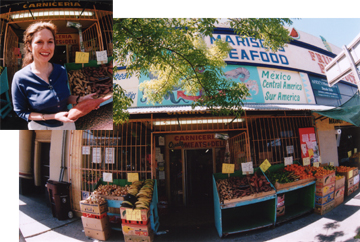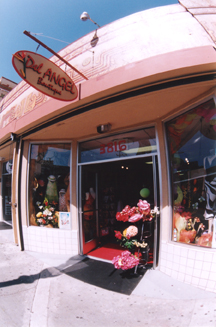The Flowering of Fruitvale

Darlene Rios Drapkin, Manager of the Fruitvale Main Street Program
Published: May, 2001
Editor’s note: I confess to jingoism here: I live in Alameda across the Oakland Estuary from the Fruitvale neighborhood and have come to love this colorful, undiscovered treasure of a neighborhood. Fruitvale reminds me of the Potrero Hill neighborhood in San Francisco. In the early 1980’s many artists moved in to what was at the time a rather gritty area, investing the neighborhood with color and style. Once they made the neighborhood cool lawyers and dot-coms evicted them, of course. But nevertheless, Fruitvale has all the gifts of Potrero Hill – beautiful natural setting (in the case of Fruitvale hard on to the Estuary) and an extraordinary inventory of under-appreciated architecture. Responsible and thoughtful revitalization of this special waterfront community is well underway, spurred by the Unity Council, community development organization staffed by the most peripatetic folks I think I have ever encountered. Bay Crossings sat down recently with Darlene Rios Drapkin, Manager of the Fruitvale Main Street Program.
What is the Fruitvale District?
Fruitvale District is in East Oakland. Historically, it’s the second downtown of Oakland, founded in the early 1900’s. In fact, it was annexed to Oakland in the early 1900’s so it used to be its own separate area. It was, in the 40’s, pretty much a lot of hustle and bustle, a lot of German immigrants. It fell into a little bit of disinvestment in the 60’s and now it’s coming back. That’s mainly due to the Fruitvale Main Street Program and the Unity Council bringing back the downtown. It’s now a predominately Latino District. Having said that, it’s pretty eclectic. It also has a large African-American community, Asian community, you name it. It’s also got a rising artist colony here too so its quite a fascinating place to be.
What is the Unity Council?
It’s a community development corporation dedicated to the social, physical and economic development of the Fruitvale District. In the past, some of it’sprograms have included Head Start, senior housing, Welfare-To-Work, first time homebuyer, family literacy. It’s developing the Union Park, open space and recreation for the area, youth programs and the program that I oversee, the Fruitvale Main Street Program, which is for commercial revitalization. The biggest project, which is up and coming, is the Fruitvale BART Transit Village. That’s a mixed housing development that’s going to cost about $60 million and should break ground in June and will be placed right over where the BART station is and will link the BART station with the whole big village to International Blvd.
What’s the transit part?
It’s really getting in touch with a lot of what Europe does. You don’t just go to a station, park your car and get on a train. The idea is to link services and activities around a BART station so there’s a lot more going on than just boarding and unboarding. There’ll be restaurants, La Clinica. Also the Unity Council will be moving its operations over there. There’ll be a lot of retail, a lot of little retail stores there and then a big plaza. It will link it to International Blvd.
There are no plans for enhanced transit then?
No, that’s not part of it. The idea is there will be a big parking structure but instead of just parking there, they can engage in some services. It’s really to give more functionality to a transit station.
How far are you from the estuary?
Our area goes to the estuary, right around where the Park Street Bridge is. We’re developing a 9-acre park that sits between the Conagra flour mill and Government Island. The Port of Oakland is one of our partners, along with the City of Oakland, the Coastal Conservancy and the Trust for Public Land. It’s happening now. We have approximately $3 million in funding. We’ll probably start construction in September or October of this year and hope to have a park in 12 months.
What’s distinctive about Fruitvale’s Main Street?
What you found in the 70’s, especially in Middle America, was that everybody started going to the Wal-Mart and you lost the sense of community in the downtowns. So the Trust for Historic Preservation introduced this Main Street approach to help downtowns re-find themselves. Shopping malls are so successful for a number of reasons. They maintain similar hours. They maintain security and cleanliness and promotion. That’s the idea with Main Street; an initiative to provide support to downtowns. We were one of six urban programs that were initiated in 1996 to institute the Main Street approach. It’s based on a four-point approach. The idea is you do something to physically improve the area. That’s design. One of the accomplishments is we’ve completed renovations of 110 facades, given them complete facelifts. We’ve secured matching funds through the merchants and gotten them to agree to fix their storefronts. Of course this made the area safer and cleaner. We’ve gotten the merchants to take ownership of the community and gotten them to understand that as long as they maintain their storefronts, they won’t attract as much of the soft-crime or the more serious crime for that matter.
Another part of our work is promotion. We’re now entering the 6th year of the Dia De Los Muertos celebration in Fruitvale, which put Fruitvale on the map. We’re attracting people that never would have thought of coming to Fruitvale because they didn’t think it was safe. Suddenly, they’re united here for a celebration of life in which we honor the dead. We create these beautiful altars the day of the festival. You can dedicate an altar to all kinds of causes, which has been wonderful for artists. We found out there were a lot of artists who were already living here that couldn’t find a way to express locally. They were going to San Francisco. Now we’ve provided them with an outlet to be able to create.
We’re trying to maintain the flavor of the existing businesses here, a lot of which are owned by immigrants, and trying to help them be better businesses by improving their products and their customer service. Our vision for the area is "ethnically and culturally diverse groups of people working together responding to a regional Latino-oriented market." That’s our vision. Everything our committees work on is around these points and around this image.
I’m a Nicaraguan-Polish-Russian-Jew raised as a Catholic. I’m bi-cultural. I have a degree in International Business from the American Graduate School of International Business. I lived in Spain for four years then traveled to about thirty countries. Now, I get my international fix on International Blvd. On a given day, I might meet a Middle Eastern merchant. When I express even the most remote interest in his religion, he says he must give me a Koran. On the same day, I might talk to a merchant from Mozambique but of Asian descent. There’s a very interesting mix out there.
Union Point Park Set for Fall
Community Dynamos Create Splendid Waterfront Park

Fruitvale’s Main Street?

Architect’s rendering of what the new park will look like. Construction starts this Fall.

